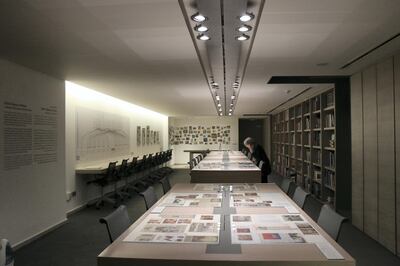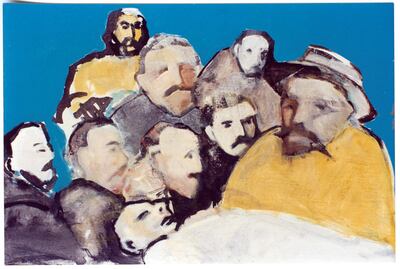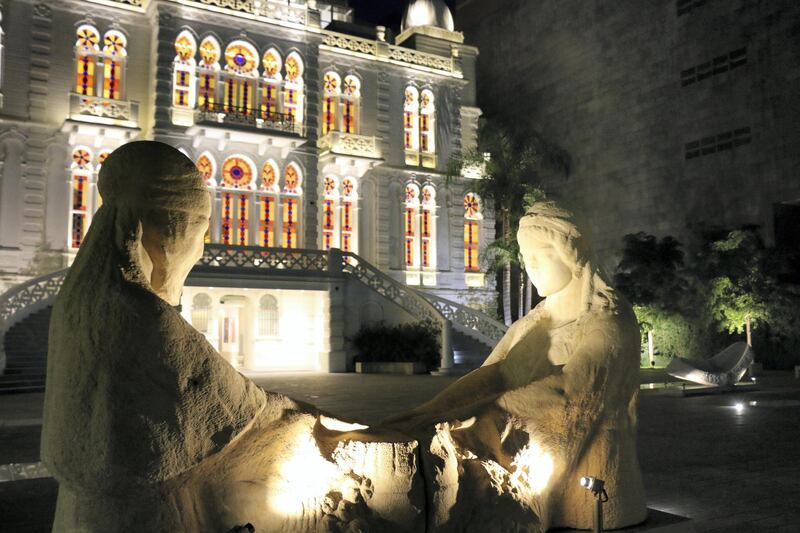In 1979, four years into Lebanon’s chaotic civil war, Lebanese art student Amal Traboulsi and German artist and art history professor Martin Giesen opened a new art gallery. They launched their inaugural show in the midst of a power cut, greeting their guests by candlelight. Against all the odds, Galerie Epreuve d’Artiste became a haven for artists who needed an escape from the conflict at a time when many galleries in Beirut were closing their doors.
Between 1979 and 2006, when the gallery closed for the final time, Epreuve d’Artiste occupied five different locations. A new book and exhibition at the Sursock Museum in Beirut explores the legacy of this unlikely venture, through the extensive archives that Traboulsi kept for more than 30 years. Flipping through her book in her art-filled flat in Beirut, she recalls the determination and optimism that kept her going through 11 years of war.

"We didn't call it a war at that time. It was events," she says. "We were used to events and we thought it would stop… Then suddenly we realised that we really were at war – but it was a very strange war. We had times of quiet and peace, so [the gallery] was a little bit about challenging what was happening. Civil war is not a very rewarding kind of war. You're not fighting an enemy, really. You're fighting your ex-friends." Traboulsi was studying art at the American University of Beirut, where Giesen was a visiting professor, when the two met. Giesen had moved to Beirut in 1973, and would remain in the country with his wife and children until 1985, when the escalating violence finally forced them to leave. When the conflict began in 1975, he volunteered to teach printmaking, etching and lithography to a group of students who were completing their art degrees.
Traboulsi was among them. They named their gallery Epreuve d’Artiste after the name given to artists’ proofs in printmaking, an art form for which they had a shared passion, and which the gallery was intended to showcase. Amid the conflict, however, they found little local appetite for prints produced by artists who lived overseas. Gradually, the gallery began to show mainly local artists’ work.
Traboulsi's new book, Galerie Epreuve d'Artiste: Chronique d'une Galerie sur Fond de Guerre (Chronicle of a Gallery Against a Backdrop of War), covers the history of the gallery over more than 25 years and five locations. Including text in French and English, as well as copies of reviews and press clippings in English, French and Arabic, the book captures the early work of artists who are now at the heart of Beirut's contemporary art scene.To accompany the book launch, the original invitation cards and posters are on show at the Sursock Museum until February 5, along with handwritten letters from artists and an array of other documents. Traboulsi has donated the entire archive to the museum, where it will be accessible to the public.
Interestingly, very few of the artists exhibiting at the gallery depicted the conflict in their work, preferring to paint pastoral landscapes recalling the days of pre-war Lebanon or seeking refuge in abstraction. “Work produced and exhibited in Lebanon between 1975 and 1985 hardly treated the war. Lebanese artists treated it from a metaphorical distance: clothed in abstractions, [and] veiled in quotations, surrealist analogies and mythological allusions,” Giesen writes.
The first artists to really engage with the conflict in their work were Jamil Molaeb and Zahi Khoury in 1980, Traboulsi recalls.

Molaeb’s eerie woodcuts and Khoury’s surreal, menacing collages feature in the early section of the book. The latter were the result of a spontaneous experiment when Khoury was trapped at the American University of Beirut.
“For four days, he was stuck in his office and the bombing was all over, and he had no electricity, no water, no nothing, just on his desk there was a calendar and scissors,” Traboulsi says. “From this, he did a whole exhibition of collages that were more or less about the war.”
Giesen, too, captured the impact of the violence through his aquarelle landscapes, which included visions of buildings scarred by bullet holes and shelling. His work was exhibited at the gallery several times over the years. Even in the 1980s, amid the chaos of war, Traboulsi and Giesen continued to show work by international artists, attracting a “small but dedicated crowd of art aficionados”, Giesen recalls.
Amid the violence, most of Beirut’s pre-war galleries had closed their doors, leaving only half a dozen or so in operation. “Our gallery became a mixture of a commercial gallery, a cultural centre and a gathering place for artists,” Traboulsi explains. “It was really very difficult, but as long as I could manage to pay my rent, I would stay open.”
In the early years, the gallery was located in Clemenceau, across the front line from Traboulsi's home in Achrafieh. Determined to continue, she braved the dangerous crossing every day. "I didn't accept that Beirut was split in two," she recalls. "Every time, it was very dangerous. We used to cross, and we used to get bullets in our car, sometimes."
When it was too dangerous to drive, she would navigate the front line on foot. “I have a friend who’s an architect, she did the same,” she says. “Every morning we used to meet, walking in our boots through the mud, because the streets were awful, and she had her wheelbarrow with her plants and I had my paintings, and we used to cross.”
In 1982, the Israelis entered Beirut and the fighting in Clemenceau intensified. For a time, Traboulsi was forced to work from home, hosting informal exhibitions and gatherings. In 1985, when Giesen left Lebanon, she closed the doors of the gallery in Clemenceau for the last time. But a year later, she reopened Epreuve d’Artiste alone, moving to a new location in Kaslik, north of Beirut. For four years, the gallery remained open.

“It was very quiet, not far from the sea, and it was a very nice experience there – until the Christians started to fight each other,” she says. In 1989, amid fierce fighting, the gallery closed again and Traboulsi went to Paris, where she organised an exhibition of Lebanese art at the Institut du Monde Arabe. “In 1991, they said the war had stopped. It was not really true, but officially the war stopped,” she says. “We cannot say that it was peace. We had car bombs, assassinations, all sorts of things. I couldn’t buy a gallery, so I had to rent, and every three years the owner would raise the rent, so I had to move to a less expensive space.”
Over the next 15 years, the gallery opened in three different locations in Beirut, but in 2006, when war with Israel started again, Traboulsi finally closed Galerie Epreuve d’Artiste. Her donation of the gallery’s archives to the Sursock Museum now ensures the safeguarding of a fascinating chapter in Lebanon’s cultural history. “What I think was especially interesting was, we didn’t show fantastic things,” Traboulsi says. “We showed what was being done at the time, which was good enough, and all the artists now are well known. They were just beginners. But it is this gathering and this family of real artists, talking together, discussing, that we don’t find anymore. This is what Epreuve d’Artiste did.”
Galerie Epreuve d’Artiste: A Selection of Documents from the Archive runs until February 5 at the Sursock Museum in Beirut. For more information, visit www.sursock.museum
______________
Read more:
[ 2017 in Review: a year of progress and creativity in the arts ]
[ British museum's living with Gods exhibition raises questions of faith and humanity ]
______________





